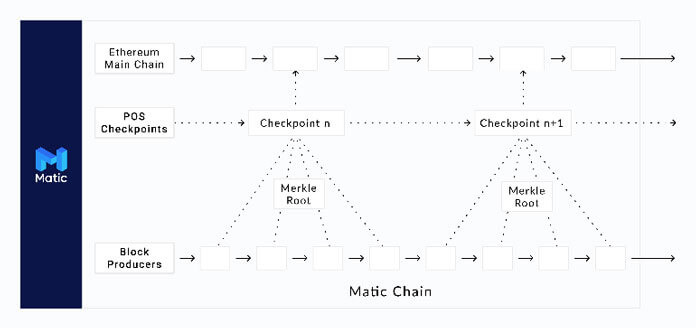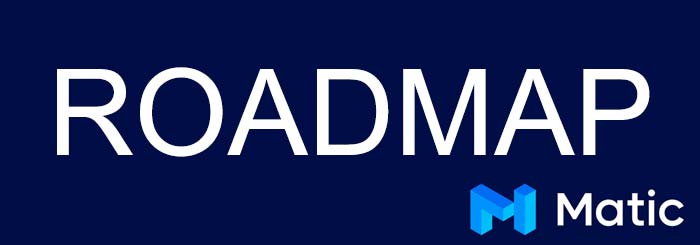Matic Network, now known as Polygon Network, is a project that proposes to scale the transactions of Ethereum’s main network through an independent network where multiple lateral channels can be included.
How does the Polygon Network work?
- A user deposits a crypto-asset in the main chain through a Smart contract of Ethereum
- Once the asset is confirmed, the token will appear in the Matic chain using a deposit bridge
- The owner of the asset can already transfer his tokens faster than in the chain of origin (Ethereum)
- When the owner of that asset wishes, he can withdraw his token to the source chain and continue operating normally in said chain
Therefore and as we have explained previously, this system presents the representation of a token of a chain of origin such as Ethereum, in a chain within a more scalable network such as Matic.
The objective is to be able to perform faster and fully scalable operations, a system similar to the payment channels of the Lightning Network but without the need to have an open channel, with the limitations that this offers in relation to the total volume of operations by the BTC blocked in said channel.
Consensus
Polygon Network proposes a dual consensus of Proof of stake (Pos) in a layer of control and Delegates in the layer of production of block, with the aim of providing a high grade of decentralization without compromising the security, all this combined with the solvency that provides the Ethereum network as a validator of the ownership of a particular asset.
- Delegates: They are in charge of the production of the blocks chosen by the stakers. The time of creation of the blocks will be less than 2 seconds and it is estimated that there could be around 7 producers so that the incentives are attractive to maintain the network.
- Stakers: In the control layer (POS) They are in charge of verifying the blocks created by the producers and propose control in the main chain of Ethereum. A conventional staking system, in which anyone with tokens can become a staker. This layer will be in charge of controlling the block producers and the contract in the Ethereum network. It is estimated that for incentives to be optimal there should be between 100 and 150 stakers.
Control mechanisms
Each certain block will create a control point, this being the basis of the POS mechanism, these control blocks will be transmitted to the stakers so that after their verification they are signed. The system will need 2/3 parts approval for this “header block” to be included in the main contract of the Ethereum network.
In addition to providing the control points, these blocks contain the burn test (removal) in the event that the tokens from the Polygon network are removed from the Ethereum source network.
Multichains
The control layer of the Polygon Network supports an unlimited number of side chains, these chains will be interoperable with each other providing greater scalability of the Polygon network and security equally in all of them.
Interoperability between origin chains
Polygon Network will start using the ethereum network as a base, however they propose to add other blockchain platforms with the aim of making a scalable and global network creating a universal platform different blockchains to each other and operate among them.
User experience
The Polygon team will focus on improving the user experience by providing a simple and easy to scale ecosystem, through the DApps users can interact without having technical knowledge.
The idea of the Polygon team is to migrate DApps created in the chain of origin Ethereum to the Matic Network, with the aim that these applications can continue to develop in a scalable, secure and interoperable environment among different blockchains.
Use cases
- Liquidity providers
- Decentralized exchanges
- Marketplaces
- Loans and credit rating
- Identity
- Games
Token sale
The sale of MATIC tokens was carried out on the Binance platform through its Launchpad, between April 24, 2019 from 8:00 AM (UTC) and lasted to April 26, 2019 at 2:00 PM (UTC).
Roadmap 2019/2020
- Mainnet Alpha – Matic Network
- NFT output token – Integration 0x – Kovan testnet
- Dagger support for matic chain
- Intelligent updatable contracts
- Security audits and improvements
MAY 2019
- Verifier / watchdog node – Alpha Launch
- NFT output token – Dharma integration – Kovan testnet
- DEX support in mobile applications
- API and SDK version v1.0 dapps
- Support Bitcoin Wrapped – Matic interoperability
JUNE 2019
- Verifier / Observer – Challenges of fraud testing
JULY 2019
- Mainnet Beta – Matic Network
- Implementation of the 0x protocol in the Matic testnet
- Rapid Plasma exit services (integrable with any implementation of third-party Plasma)
AUGUST 2019
- NFT output token – Integration 0x – Ethereum mainnet core
SEPTEMBER 2019
- Integration of the liquidity fund
- Matic Network – Mainnet interoperability
- Matic Side chain Matic App Store dapps
- Interoperability of Bitcoin assets – Testnet interoperability
OCTOBER 2019
- Government research and pilot implementation
NOVEMBER 2019
- Implementation of the Dharma protocol in Matic Testnet
DECEMBER 2019
- NFT output token – Dharma integration – Ethereum mainnet
- Business support for sidechains Matic
- Business services
MARCH 2020
- Generalized fraud tests – Testnet Alpha
Team
Jaynti Kanani (Co-founder and CEO)
Jaynti Kanani, Full stack developer and blockchain engineer, is one of the founders of Matic Network, previously he has worked in Housing.com as Senior Software Developer or in Function Space Labs as Full stack developer.
- Twitter: https://twitter.com/_jdkanani
Sandeep Nailwal (Co-founder and COO)
Programmer and Entrepreneur Blockchain, Sandeep Nailwal is another founder of the project, he has also been Co-founder and CEO of ScopeWeaver.com and Head of Technology and Supply Chain, in the Electronic Commerce Division of the Welspun Group.
- Twitter: https://twitter.com/sandeepnailwal
Anurag Arjun (Co-founder and CPO)
Anurag Arjun has previously worked as AVP, Product Management at IRIS Business Services Limited or as Project Manager II / Scrum Master at SNL Financial.
Twitter: https://twitter.com/_anuragarjun
You can follow and get more information about the project in their social networks:
Telegram: https://t.me/maticnetwork
Twitter: https://twitter.com/maticnetwork
Medium: https://medium.com/matic-network





